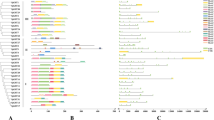Abstract
Genetic responses of the seaweed Ulva pertusa to pine needle ash have been compared using differential display technique. The tissue viability was assessed to evaluate the stress level with triphenyltetrazolium chloride. Total RNA, from tissues treated in seawater containing ash, was reverse transcribed and amplified by PCR with arbitrary primers. The genetic fragments responding to the stress were selectively isolated from agarose gel and sequenced with a DNA auto sequencer. According to sequence analysis, an ash-inducible gene (342 bp) and an ash-suppressed gene (1690 bp) were identified as hypothetical proteins.
Access this chapter
Tax calculation will be finalised at checkout
Purchases are for personal use only
Preview
Unable to display preview. Download preview PDF.
Similar content being viewed by others
References
Asahina T, Kanno T, Onodera T, Saito H (1999) Substances for hastening the growth of Ulva pertusa in treated wastewater. Bull. Jpn. Soc. Sci. Fish. 65: 810–817.
Burrows EM (1971) Assessment of pollution effects by the use of algae. Proc. Roy. Soc. London, Ser. B, 177: 295–306.
Fletcher RL (1991) Marine macroalgae as bioassay test organisms. In Abel PD, Axiak V (eds), Ectoxicology and the Marine Environment. Ellis Horwood Ltd., New York, pp. 111–131.
Floreto EAT, Hirata H, Ando S, Yamasaki S (1993) Effects of temperature, light intensity, salinity and source of nitrogen on the growth, total lipid and fatty acid composition of Ulva pertusa Kjellman (Chlorophyta). Bot. Mar. 36: 149–158.
Hong YK, Sohn CH, Polne-Fuller M, Gibor A (1995) Differential display of tissue-specific messenger RNAs in Porphyra perforata (Rhodophyta) thallus. J. Phycol. 31: 640–643.
** HJ, Seo GM, Cho YC, Hwang EK, Sohn CH, Hong YK (1997) Gelling agents for tissue culture of the seaweed Hizikia fusiformis. J. Appl. Phycol. 9: 489–493.
Liang P, Pardee AB (1992) Differential display of eukaryotic messenger RNA by means of the polymerase chain reaction. Science 257: 967–971.
Lim BL, Hori H, Osawa S (1983) The nucleotide sequences of 5S rRNAs from a multicellular green alga, Ulva pertusa, and two brown algae, Eisenia bicyclis and Sargassum fulvellum. Nucl. Acids Res. 11: 1909–1912.
Nakanishi K, Nishijima M, Nishimura M, Kuwano K, Saga N (1996) Bacteria that induce morphogenesis in Ulva pertusa (Chlorophyta) grown under axenic conditions. J. Phycol. 32: 479–482.
Nam BH, ** HJ, Kim SK, Hong YK (1998) Quantitative viability of seaweed tissues assessed with 2,3,5-triphenyltetrazolium chloride. J. Appl. Phycol. 10: 31–36.
Okano M, Aratani T (1979) Constituents in marine algae. 1. Seasonal variation of sterol, hydrocarbon, fatty acid, and phytol fractions in Ulva pertusa. Bull. Jpn. Soc. Sci. Fish. 45: 389–393.
Perez-Fernandez MA, Rodriguez-Echeverria S (2003) Effect of smoke, charred wood, and nitrogenous compounds on seed germination of ten species from woodland in central-western Spain. J. Chem. Ecol. 29: 237–251.
Provasoli L (1968) Media and prospects for the cultivation of marine algae. In Watanabe A, Hattori A (eds), Cultures and Collections of Algae. The Japanese Society of Plant Physiologists, Tokyo, pp. 63–75.
Reddy CRK, Iima M, Fujita Y (1992) Induction of fast-growing and morphologically different strains through intergeneric protoplast fusions of Ulva and Enteromorpha (Ulvales, Chlorophyta). J. Appl. Phycol. 4: 57–65.
Rubinelli P, Siripornadulsil S, Gao-Rubinelli F, Sayre RT (2002) Cadmium-and iron-stress-inducible gene expression in the green alga Chlamydomonas reinhardtii: Evidence for H43 protein function in iron assimilation. Planta 215: 1–13.
Yu K, Pauls KP (1992) Optimization of the PCR program for RAPD analysis. Nucl. Acids Res. 20: 2606.
Author information
Authors and Affiliations
Editor information
Editors and Affiliations
Rights and permissions
Copyright information
© 2006 Springer
About this paper
Cite this paper
Kang, SE., **, LG., Choi, JS., Cho, JY., Shin, HW., Hong, YK. (2006). Isolation of pollutant (pine needle ash)-responding genes from tissues of the seaweed Ulva pertusa . In: Anderson, R., Brodie, J., Onsøyen, E., Critchley, A.T. (eds) Eighteenth International Seaweed Symposium. Developments in Applied Phycology, vol 1. Springer, Dordrecht. https://doi.org/10.1007/978-1-4020-5670-3_32
Download citation
DOI: https://doi.org/10.1007/978-1-4020-5670-3_32
Publisher Name: Springer, Dordrecht
Print ISBN: 978-1-4020-5669-7
Online ISBN: 978-1-4020-5670-3
eBook Packages: Biomedical and Life SciencesBiomedical and Life Sciences (R0)




